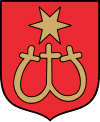 Alternate names: Pilica [Pol], Piltz [Yid], Pilitza, Пилица [Rus, Ger], Pilitsa, Pilitz, Pilts. 50°28' N, 19°39' E, 51 miles WSW of Kielce, 29 miles NNW of Kraków, 13 miles NNE of Olkusz, 10 miles ESE of Zawiercie Zawiercie County, Silesian Voivodeship with 1,948 inhabitants in 2004. . 1900 Jewish population: 2,688. JOWBR burial list: Jewish Cemetery. Słownik Geograficzny Królestwa Polskiego (1880-1902), VIII, pp. 135-139: "Pilica". [June 2009]
Alternate names: Pilica [Pol], Piltz [Yid], Pilitza, Пилица [Rus, Ger], Pilitsa, Pilitz, Pilts. 50°28' N, 19°39' E, 51 miles WSW of Kielce, 29 miles NNW of Kraków, 13 miles NNE of Olkusz, 10 miles ESE of Zawiercie Zawiercie County, Silesian Voivodeship with 1,948 inhabitants in 2004. . 1900 Jewish population: 2,688. JOWBR burial list: Jewish Cemetery. Słownik Geograficzny Królestwa Polskiego (1880-1902), VIII, pp. 135-139: "Pilica". [June 2009]
The first documentation of the Jewish community in Pilica was in 1581 regarding local Jews accused of violation the host, for which they risked a huge financial penalty. A synagogue, cheder, mikvah, and the cemetery were all part of the kahal. The cemetery was outside the city, probably near the Franciscan monastery on the 19th century Kierchoffu Old Street (now ulica Klasztorna). The cemetery is only known now by historical documents. After 1635, the then heir to the town of Stanisław banned Jews from Warszycki Pilica, giving the brick, vaulted synagogue with a shingled roof to the Church of St. Barbara. The next heir agreed to resettle Jews in Pilica after 1690. These Jews settled in a new place on the river at present-day ulica Łazienna where they established the Modrzewiowa synagogue and brick cheder and brick mikvah. In 1731, 1733, 1753, and 1787, Jews were given the privilege and developed the village. In 1763, the last meeting of the Sejm of Four Lands took place here, a meeting of delegates of the Jewish populace in Poland since the16th century that had the power to legislate and enforce of taxes on individual Jewish communities, settle Jewish affairs and disputes across the country, and represent the Jewish community with Polish monarchs. An 1721 document stored in the Archives of the Parish Pilicy is a request by the Jewish community to pay for the land for the old cemetery when the leaders of the Jewish community were Jakub MichaŁowicz and Jakub and Solomon Lewkowiczow, who requested permission to bury bodies for which they had to pay three stones of tallow per annum. Normal 0 The Old Cemetery from 1842 lasted until it was destroyed during WWII. The rapid development of the Jewish community meant that the facility quickly was filled, but now the only trace of matzevot is a few gravestones built as foundations of nearby buildings. [June 2009]
NEW CEMETERY: After a long dispute between the Catholic pastor and the Jewish community in 1842, the burial place in the Black Forest behind the town on the way to the village Kocikowa served until the end of WWII. Pilica provided water needed for ritual purification in the tahara that was destroyed. In 1942, the Nazis locked the Jewish population in the ghetto in Wolbrom. Executions of Jews took place in the cemetery and surrounding forests in 1942 and 1943. In 1945, the Wolbrom police shot around 70 people from Pilicy and the surrounding area here. The last two gravestones erected after the war commemorate murdered Pańkowski family members. The 1 ha cemetery contains 327 gravestones in various states of conservation from fully restored to the barely legible. The book "Jurassic Judaica" published by the Association of Municipalities Jurajskich in Katowice in 2005 mistakenly states that the cemetery is on Mickiewicza Street, destroyed and illegible, but this is a Christian cemetery. Photos. [June 2009]
I just purchased a copy of Cmentarz Zydowski W Pilicy (The Jewish Cemetery in Pilica) published in 1995 by the Judaica Foundation, 31-135 Krakow, 12 Bartorego Street. The cost is $18 postage included. The book contains photographs of every tombstone in the cemetery in Pilica with a transcription in Hebrew and Polish of the epitaphs on each stone. There is also a map of the cemetery showing where each stone is located. The cemetery dates back only to the late 1800's. Most, but not all, of the stones have surnames. There is no comparable book for any other town in Poland. Source: Jeff Cymbler This email address is being protected from spambots. You need JavaScript enabled to view it.. Aother offer to look up names: Alex Kerner, Israel; e-mail address: This email address is being protected from spambots. You need JavaScript enabled to view it.. [June 2009]
PILICA: (I) and (II) US Commission No. 000555 and 000556. In Katowickie. The US Commission is not finished rechecking this file. [2000]
